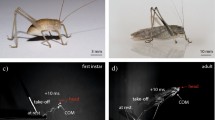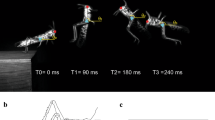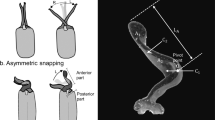Abstract
Small animals that jump or perform predatory strikes depend on much higher limb accelerations than larger animals. To overcome the temporal restrictions of muscle contraction, some arthropod muscles slowly load spring-like structures with potential energy. In flight, sound generation, jumping, or predatory strikes arthropods employ different strategies to transform muscular action to the desired movement. Click mechanisms control the frequency of oscillating spring — muscle systems while other accessory structures such as snap mechanism or latches with trigger mucles determined the stability and control the timing of the instantaneous discharge in catapult mechanisms.
Similar content being viewed by others
References
Alexander RMcN (1966) Rubber-like properties of the inner hinge-ligament of Pectinidae. J Exp Biol 44: 119–130
Alexander RMcN (1988) Elastic mechanisms in animal movement. Cambridge Univ Press, Cambridge, pp 81–90
Alexander, RMcN (1995) Leg design and jumping technique for humans, other vertebrates and insects. Phil Trans R Soc Lond B 347: 235–248
Alexander RMcN, Bennet-Clark HC (1977) Storage of elastic strain energy in muscle and other tissues. Nature 265: 114–117
Andersen SO, Weis-Fogh T (1964) Resilin. A rubberlike protein in arthropod cuticle. Adv Insect Physiol 2: 1–65
Bauer T, Kredler M (1988) Adhesive mouthparts in a ground beetle larva (Coleoptera, Carabida, Loricera pilicornis F.) and their function during predation. Zool Anz 221: 145–156
Bauer T, Völlenkle W (1976) Hochfrequente Filmaufnahmen als Hilfsmittel bei der Analyse von Angriffs- und Fluchtverhalten in einer Räuber-Beute-Beziehung unter Bodentieren (Collembolenfang visuell jagender Carabiden). Wiss Film Wien 17: 4–11
Bennet-Clark HC (1975) The energetics of the jump of the locust Schistocerca gregaria. J Exp Biol 63: 53–83
Bennet-Clark HC, Lucey ECA (1967) The jump of the flea: a study of the energetics and a model of the mechanism. J Exp Biol 47: 59–76
Bennet-Clark HC, Young D (1992) A model of the mechanism of sound production in cicadas. J Exp Biol 173: 123–153
Blest AD, Collett TS, Pye JD (1963) The generation of ultrasonic signals by a New World arctiid moth. Proc R Soc Lond B 158: 196–207
Boettiger EG (1955) Triggering the contraction process in insect fibrillar muscle. J Cell Comp Physiol 46: 370–371
Boettiger EG, Furshpan E (1952) The mechanics of flight movements in Diptera. Biol Bull 102: 200–211
Brodsky AK (1994) The evolution of insect flight. Oxford University Press, Oxford New York Tokyo
Brown WL, Wilson EO (1959) The evolution of the dacetine ants. Q Rev Biol 34: 278–294
Burrows M (1969) The mechanism and neural control of the prey capture strike in the mantid shrimps Squilla and Hemisquilla. Z Vergl Physiol 62: 362–382
Christian E (1979) Der Sprung der Collembolen. Zool Jb Physiol 83: 457–490
Cullen MJ (1975) The jumping mechanism of Xenopsylla cheopis II. The fine structure of the jumping muscle. Phil Trans R Soc Lond B 271: 491–497
Dietz BH, Brandao CRF (1993) Comportamento de caca e dieta de Acanthoynathis rudis Brown & Kempf, com comentarios sobre a evolucao da predacao em dacetini (Hymenoptera, Formicidae, Myrmicinae). Revta Bras Ent 37: 683–692
Ennos AR (1987) A comparative study of the flight mechanism of Diptera. J Exp Biol 127: 355–372
Evans MEG (1972) The jump of the click beetle (Coleoptera: Elateridae) — a preliminary study. J Zool Lond 167: 319–336
Evans MEG (1973) The jump of the click beetle (Coleoptera: Elateridae) — energetics and mechanics. J Zool Lond 169: 181–194
Fullard JH, Heller B (1990) Functional organization of the arctiid moth tymbal (Insecta, Lepidoptera). J Morphol 204: 57–65
Furth DG, Traub W, Harpaz I (1983) What makes Blepharida jump? structural study of the metafemoral spring of a flea beetle. J Exp Zool 227: 43–47
Gronenberg W (1995a) The fast mandible strike in the trap-jaw ant Odontomachus: temporal properties and morphological characteristics. J Comp Physiol A 176: 391–398
Gronenberg W (1995b) The fast mandible strike in the trap-jaw ant Odontomachus: motor control. J Comp Physiol A 176: 399–408
Gronenberg W, Ehmer B (1995) Tubular muscle fibers in ants and other insects. Zoology 99: 68–80
Gronenberg W, Tautz J, Hölldobler B (1993) Fast trap jaws and giant neurons in the ant Odontomachus. Science 262: 561–563
Heitler WJ (1974) The locust jump. J Comp Physiol 89: 93–104
Hoyle G (1955) Neuromuscular mechanisms of a locust skeletal muscle. Proc R Soc Lond B 143: 343–367
Hoyle G (1978) Distribution of nerve and muscle fibre types in the locust jumping muscle. J Exp Biol 73: 205–233
Huxley AF (1974) Review lecture: Muscular contraction. J Physiol (Lond) 243: 1–43
Huxley AF, Simmons RM (1971) Mechanical properties of the cross bridges of frog striated muscle. J Physiol (Lond) 218: 59–60
Huxley HE (1965) The mechanism of muscular contraction. Sci Amer 213: 18–27
Jensen M, Weis-Fogh T (1962) Biology and physics of locust flight. V. Strength and elasticity of locust cuticle. Phil Trans R Soc (Lond) B 245: 137–169
Josephson RK, Young D (1985) A synchronous insect muscle with an operation frequency greater than 500 Hz. J Exp Biol 118: 185–208
Josephson RK, Young D (1987) Fiber ultrastructure and contraction kinetics in insect fast muscles. Am Zool 27: 991–1000
Krisper G (1990) The jump of the mite-genus Zetorchestes (Acarida, Oribatida). Zool Jb Anat 120: 289–312
Machin KE, Pringle JWS (1960) The physiology of insect fibrillar muscle. III The effect of sinusoidal changes of length on a beetle flight muscle. Proc R Soc (Lond) B 152: 311–330
Miyan JA, Ewing AW (1985) Is the ‘click’ mechanism of dipteran flight an artefact of CCl4, anaesthesia? J Exp Biol 116: 313–322
Nachtigall W (1974) Biological mechanisms of attachment. Springer, Berlin Heidelberg New York
Pringle JWS (1949) The excitation and contraction of the flight muscles of insects. J Physiol (Lond) 108: 226–232
Pringle JWS (1954) A physiological analysis of cicada song. J Exp Biol 31: 525–560
Pringle JWS (1957) Insect flight. Cambridge University Press, Cambridge
Pringle JWS (1976) The muscle and sense organs involved in insect flight. In: Rainey RC (ed) Insect flight. Blackwell, Oxford London Edinborough Melbourne pp 3–15
Rothschild M, Schlein Y (1975) The jumping mechanism of Xenopsylla cheopis I. Exoskeletal structures and musculature. Phil Trans R Soc Lond B 271: 457–490
Rothschild M, Schlein Y, Parker K, Neville C, Sternberg S (1973) The flying leap of the flea. Sci Am 229: 92–99
Rothschild M, Schlein Y, Parker K, Neville C, Sternberg S (1975) The jumping mechanism of Xenopsylla cheopis III. Execution of the jump and activity. Phil Trans R Soc Lond B 271: 499–515
Ruegg JC (1968) Contractile mechanisms of smooth muscle. Symp Soc Exp Biol 22: 45–66
Sannasi A (1969) Resilin in the cuticle of a click beetle. J Georgia Entomol Soc 4: 31–32
Schmidt-Nielsen K (1983) Animal physiology: Adaptation and environment. 3. ed. Cambridge University Press, Cambridge London New York New Rochelle Melbourne Sydney, pp 443–445
Simmons P, Young D (1978) The tymbal mechanism and song patterns of the bladder cicada Cystosoma saundersii. J Exp Biol 76: 27–45
Snodgrass RE (1935) Principles of insect morphology. McGraw-Hill, New York London
Sotavalta O (1947) The flight-tone (wing-stroke frequency) of insects. Acta entomoe fenn 4: 1–117
Sotavalta O (1953) Recordings of high wing-stroke and thoracic vibration frequency in some midges. Biol Bull 104: 439–444
Tanaka Y, Hisada M (1980) The hydraulic mechanism of the predatory strike in dragonfly larvae. J Exp Biol 88: 1–19
Tregear RT (1975) The biophysics of fibrillar flight muscle. In: Usherwood PNR (ed) Insect muscle. Academic Press, London New York San Francisco, pp 357–403
Weis-Fogh T (1960) A rubber-like protein in insect cuticle. J Exp Biol 37: 889–907
Young D, Bennet-Clark HC (1995) The role of the tymbal in cicada sound production. J Exp Biol 198: 1001–1019
Author information
Authors and Affiliations
Rights and permissions
About this article
Cite this article
Gronenberg, W. Fast actions in small animals: springs and click mechanisms. J Comp Physiol A 178, 727–734 (1996). https://doi.org/10.1007/BF00225821
Accepted:
Issue Date:
DOI: https://doi.org/10.1007/BF00225821




